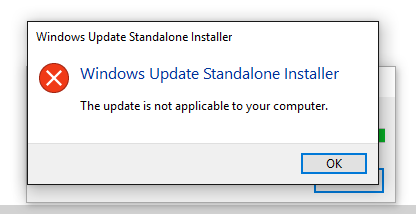Unable to Install Windows Media Feature Pack? Fix it NOW!
If you are unable to install the Windows Media Feature Pack on your computer, it indicates that the installation process of the Windows Media Feature Pack has been interrupted. This may happen due to compatibility issues with the current Windows version or misconfigurations in network settings, which could prevent the Windows Media Feature Pack from installing without any errors.

1. Try installing through Windows features
If you have never tried installing the Windows Media Feature Pack through Windows Features, attempt it as it is one of the simplest ways to install any extra features on Windows. To do so, simply follow these steps:
- Click the Start Menu and type Turn Windows features on or off.

- Hit Enter to open the Windows features Window.
- Find and tick the Media features option. Then, expand the media features and tick the Windows Media Player option.

- Click OK to install the Windows media feature. If you are facing the error message, try installing the Windows media feature by navigating to the Apps and Features settings.
2. Download the Windows Media Feature Pack from Microsoft
You can also try downloading the Windows Media Feature Pack from the official Microsoft site. It is a simple way to install the Windows Media Feature Pack. To do so, follow these steps:
- Download the Windows Media Feature pack through the link.
- Make sure to download it according to the Windows architecture or system type.

- To find out the Windows architecture or system type, click the Start Menu and type About your PC.
- Hit Enter to open the About settings of your PC.

- Here check the System type to download the media pack according to it.

- Once done, run the Windows media pack installer and see whether you are getting the error or not.
3. Install Windows Media Feature Pack using Windows PowerShell
You can also use Windows PowerShell to install the Media Feature Pack. However, if your Windows version is incompatible with the Media Feature Pack, you cannot install it unless you upgrade your Windows version. Therefore, if this method fails to install the Media Feature Pack, move on to the next method. Follow the steps to install the Media Feature Pack.
- Open the Start Menu by clicking the Windows logo.
- Search the Windows Powershell and right-click on it to open it as an administrator.

- Then, enter the following command to determine the version of the Windows media feature pack.
DISM /Online /Get-Capabilities

- Then enter the following command and replace the Windows Media Feature Pack name with the version name.
DISM /Online /Add-Capability /CapabilityName:<Windows Media Feature Pack name>
- The command should be similar to as shown in the following example.
DISM /Online /Add-Capability /CapabilityName:Media.MediaFeaturePack~~~~0.0.1.0

- Now hit Enter to execute the command.
- If you are getting the error message after executing the command, move on to the next methods.
4. Turn off Metered Connection
Windows features often fail to install when the metered connection is turned on. This is because the metered connection allows users to reduce data usage, as it prevents certain Windows processes from consuming internet resources, such as Windows updates, Windows features, and idle background applications.
If you have a limited internet package and you used metered connection, then temporarily turn it off to install the Windows Media feature pack. To do so, follow the steps:
- Navigate to Settings by using the combination of Win + I keys.
- Then go to Network and Internet and open the Ethernet settings. If you have a Wi-Fi connection, open the Wi-Fi settings.

- Here turn off the Mertred connection by toggling off the button.

- Once done, try installing the Windows media feature pack using the 1st method.
5. Update your Windows
You may have a compatibility issue between Windows and the Media Feature Pack. If that is the case, you need to update your Windows in order to install the Media Feature Pack.
There are many ways to update your Windows. If you encounter any error messages while trying to update Windows from the settings, you can either use the Windows Update Assistant or manually download the Windows update from the Microsoft catalog.
- To update Windows, open the Start Menu by pressing the Win key.
- Search Check for updates and hit Enter to open the Windows update settings.

- Click Check for updates and then click Download and Install.

- Once the updates are downloaded, restart your computer to install the updates.
6. Reset the network settings
Since this problem could occur due to a slow network connection, it is possible that your internet connection might be slow because of misconfigurations in the network settings, such as having a slow DNS (Domain Name System) or proxy server.
To ensure network stability, try resetting the network settings, which will reinstall the network adapters, reassign the IP addresses, flush the DNS cache, and reset the network settings to default. To do so, follow these steps:
- Press the Start Menu button and search Network reset.
- Hit Enter to open the network reset settings.

- Click the Reset Now button to reset the network settings. Your computer will restart with default network settings.

- Once done, try installing the Windows media feature pack.
Unable to Install Windows Media Feature Pack- FAQs
Windows media feature pack might refuse to install due to compatibility issues between the Windows and the media feature pack. Moreover, if you have a metered connection enabled, you should turn it off temporarily because it prevents certain Windows processes from using the network resources.
Press the Win keys and type Turn Windows features on or off and press Enter to open the settings. Here expand the Media Features and tick Windows Media Player. Once done, click OK to install the media feature pack.
 Reviewed by
Reviewed by 



